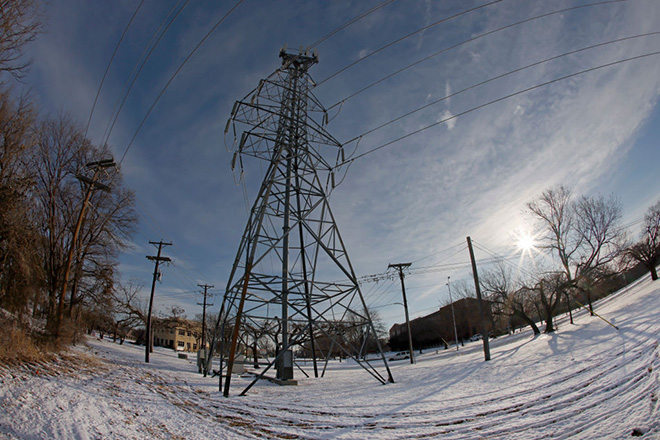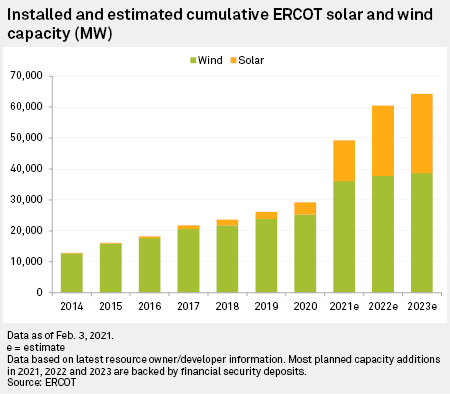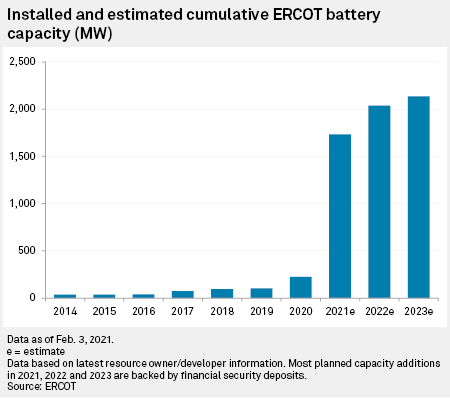S&P Global Offerings
Featured Topics
Featured Products
Events
S&P Global Offerings
Featured Topics
Featured Products
Events
S&P Global Offerings
Featured Topics
Featured Products
Events
Banking & Capital Markets
Economy & Finance
Energy Transition & Sustainability
Technology & Innovation
Podcasts & Newsletters
Banking & Capital Markets
Economy & Finance
Energy Transition & Sustainability
Technology & Innovation
Podcasts & Newsletters
S&P Global Offerings
Featured Topics
Featured Products
Events
19 Feb, 2021

| Power lines in Fort Worth, Texas, on Feb. 16, 2021, after a historic winter storm forced widespread power outages across the state. Solar and wind are poised to play a greater role as Texas recovers from the energy crisis. Source: Ron Jenkins/Stringer via Getty Images |
As Texas power plant operators and grid managers revive the state's storm-battered electric system and prepare for an uncertain future, one thing appears unlikely to change: the rapid proliferation of renewable energy resources in the nation's largest power market.
Between 2021 and 2023, developers plan to add roughly 35 GW of combined solar and wind capacity to the state's primary transmission system, operated by the Electric Reliability Council Of Texas Inc., according to the grid operator's most recent data. The near-term additions — which are largely underpinned by financial security deposits for interconnection, federal tax incentives and power purchase agreements — would more than double ERCOT's solar and wind footprint to 64 GW in just three years.
 |
Natural gas, which now dominates the state's power mix, accounts for nearly 60 GW of ERCOT's winter capacity, S&P Global Market Intelligence data shows.
Texas has emerged as America's leading renewable energy market, with its recent rise in solar riding the coattails of an ongoing wind boom. But this week's energy crisis, which resulted in prolonged power outages for millions of residents, has revealed considerable backlash to the state's clean energy transition. Texas Gov. Greg Abbott, for instance, was among a host of renewable energy critics who claimed falsely that frozen wind turbines and snow-covered solar arrays were the primary culprits in the power system's collapse that started early Feb. 15.
"This shows how the Green New Deal would be a deadly deal for the United States of America," Abbott said Feb. 16 on Fox News. "Our wind and solar got shut down, and they were collectively more than 10% of our power grid, and that thrust Texas into a situation where it was lacking power [on] a statewide basis."
That was not the case, according to ERCOT officials. Of the approximately 46 GW of generating capacity that was out of service as of midday Feb. 17, 28 GW was thermal power plants and 18 GW was renewables, according to ERCOT officials. "We're really just seeing the impacts of this weather event go across wind, solar, coal, nuclear, gas, across the industry," ERCOT President and CEO Bill Magness said during a Feb. 17 media briefing when asked to respond to Abbott's comments.
|
|
Don't mess with Texas
"Texas is a warm-weather state experiencing once-in-a-generation cold-weather," Heather Zichal, CEO of the American Clean Power Association, a renewable energy trade group, said in a statement. "It is an extreme weather problem, not a clean power problem. ... Don't mess with Texas, just tell the truth, and get the power back on for people."
One simple way of making renewable energy projects in Texas more resilient in the face of frigid winter conditions is to equip facilities with "cold weather packages" that can de-ice machines and keep them running, said Paul Denholm, a principal energy analyst at the National Renewable Energy Laboratory. Wind farm operators routinely do that in places such as North Dakota, the Upper Midwest, Canada and Europe's Nordic countries.
But there is a catch, Denholm added. "If you really want more reliability, you're going to have to pay for it."
Storage 'part of the solution'
As variable wind and solar resources multiply in Texas, energy storage is poised to play a bigger role in balancing supply and demand.
According to ERCOT data, installed battery capacity connected to its system could jump to 1.7 GW in 2021 and to more than 2 GW in 2022 from 225 MW in 2020. But that just scratches the surface of the more than 26 GW of large-scale battery storage under study in ERCOT's deeper interconnection queue — more than wind and second only to solar.
The outages could also ignite demand for backup batteries at homes and businesses, according to Jason Burwen, interim CEO at the U.S. Energy Storage Association.
 |
"The most immediate way storage can help is for the end user," Burwen said in an interview. Charging batteries on rooftop solar arrays, for instance, could help households power critical loads for a few hours a day during prolonged outages or could form the foundation of independently operating microgrids combining a variety of fossil and renewable resources.
Burwen sees a need for a diverse set of energy storage resources as Texas' power market evolves, from lithium-ion batteries to hydrogen made with renewable resources.
"There is no silver bullet, but energy storage is part of the solution," he said.

